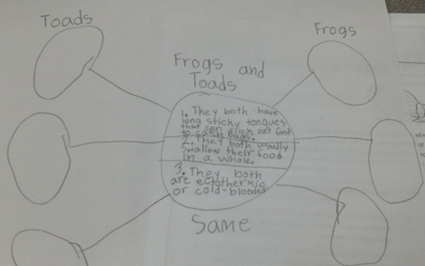My colleagues and I have been digging into the Reading Standards of the Common Core. As part of our learning, we decided to explore the steps of a close read. We first defined close reading as the balance between crafting understanding directly from the text, and blending that with a reader’s interpretation of the text. Next we decided to explore ways to engage our students in a close read of a text. This is an experience I had with third-graders.
I was invited by one of the third-grade teachers to co-teach a lesson.
The teacher and I met prior to co-teaching the lesson to talk about what the students were working on in Making Meaning (Expository Nonfiction, Flashy Fantastic Rain Forest Frogs). I found a passage comparing frogs and toads (superteacherworksheets.com) to connect the content for the students. I introduced the steps of a close read to the class, explaining that we were going to not only learn more about frogs and toads, but also learn a strategy that could help them when reading anything.
The lesson started with a discussion around the question: How can a close read of a text help improve comprehension? This was our essential question. Then the students and I worked through the first two paragraphs together (on the chart) using the steps outlined for them.

Writing. Reading. Speaking. Listening. Communication. Making Connections. The students experienced so many best practices in reading! I was beyond excited to be a part of this learning experience today!
In what ways do you engage students in a close read of a text? What resources have you used to learn more about close reading? Please share your ideas in the comments section. For more ideas on engaging students in close reads you might enjoy Katy Cortelyou’s blog post about close reading.
*Steps to a close read adapted from Fisher, D., Frey, N., & Lapp, D., Text Complexity Raising Rigor in Reading (2012).
